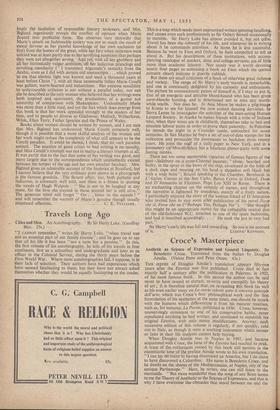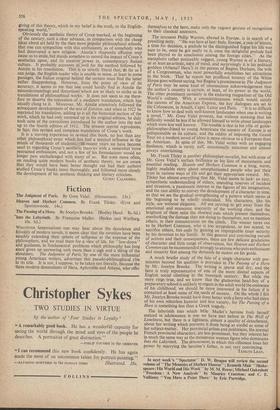Croce's Masterpiece
Aesthetic as Science of Expression and General Linguistic. By Benedetto Croce. Translated from the. Italian by Douglas Ainslie. (Vision Press and Peter Owen. 42s.) Tins reprint of Douglas Ainslie's translation' appears fifty-one years after the Estetica was first published. Croce died in 'fact exactly half a century after the publication in Palermo, in 1902, of his most famous book. In this period the author can be said never to, have ceased to correct, re-write and exemplify his theory of art ; it, is therefore natural that, on re-reading this book (as well as his even earlier essay on La storta ridotta sotto il conceito generale dell'arte, which was Croce's first philosophical work and the first formulation of his aesthetics at the same time), one should be struck with the features which differentiate it from his maturer treatises, such as, for instance, La Poesia, published in 1936: Croce, however, unswervingly consistent to one, of his conservative habits, never repudiated anything he had written, and continued to republish his original Estetica, with only minor modifications. Anyway, each successive edition of this volume is regularly, if not quickly, sold out in Italy, as though it were a working instrument which sooner or later in their life students cannot help buying.
When Douglas Ainslie was in Naples in 1907, and became acquainted with Croce, the fame of the Estetica had reached its peak. A trace of the enthusiasm roused by this book still persists in the encomiastic tone of the preface Ainslie wrote to his own translation. "1 can lay no claim to having discovered an America, but I do claim to have discovered a Columbus. His name is Benedetto Croce, and he dwells on the shores of the Mediterranean, at Naples, city of the antique Parthenope." Here, he writes, one can still listen to the mermaids. "But more wonderful than the song of any Siren seems to me the Theory of Aesthetic as the Science of Expression, and that is why I have overcome the- obstacles that stood between me and the giving of this theory. which in my belief is the truth, to the English- speaking world." Obviously the aesthetic theory. of Croce marked, at the beginning of the century, such a clear advance, in comparison with the cheap ideas about art held by the then more popular philosophical schools, that one can• sympathise with this enthusiasm, as of somebody who had discovered a new religion. Ainslie's rhapsodic effusion may cause us to smile, but stands somehow to record the impact of Croce's aesthetics upon, and its creative power in, contemporary Italian , culture. It probably.accounts as well for the method followed by Ainslie in his translation. This is so strictly literal that, is far as I can judge, the English reader who is unable to sense, at least in some passages, the Italian original behind the version must find the latter rather disappointing. However, from the point of view of its accuracy, it seems to me that one could hardly find in Ainslie the misunderstandings and distortions which are so likely to strike us in translations of philosophical works. It does not seem to me there- fore to deserve the reputation of a mediocre translation, which has usually clung to it. Moreover, Mr. Ainslie attentively followed the subsequent developments of the text of Estetica, and when in 1922 he reprinted his translation, adding to it all the historical section of the work, which he had only summed up in his original edition, he duly took note of the corrections introduced by the author into the text up to the fourth edition .of 1912. The present reprint reproduces, in fact, this revised and complete translation of Croce's work.
It is a moving experience to re-read this book, no less than any other philosophical essay which has had a seminal influence in the Minds of thousands of students... b -recent years we have become used to regarding Croce's aesthetic theories' with a somewhat more restrained enthusiasm, and not a few of his formulations would no longer pass unchallenged with many of us. But even more often, on reading quite modern books of aesthetic theory, we are aware that they would have been better thought out had their authors `studied Croce's books more thoroughly, and followed more closely the development of his aesthetic thinking and literary criticism.
GUIDO CALOGERO.



































 Previous page
Previous page